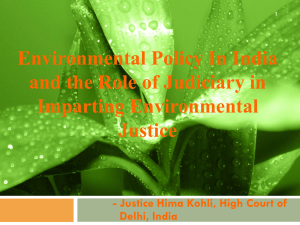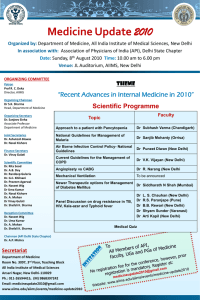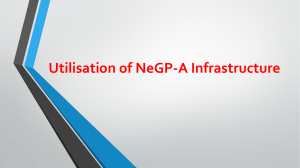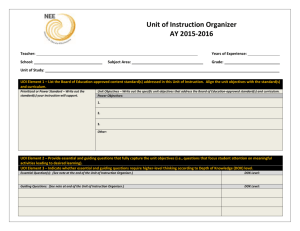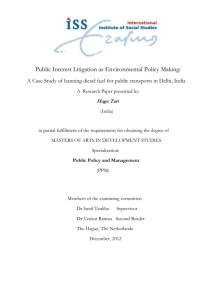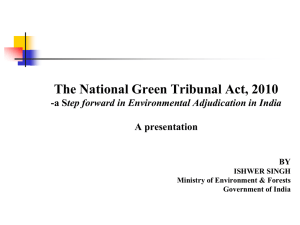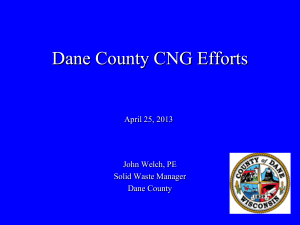MC Mehta vs UOI - Asian Judges Network on Environment (AJNE)
advertisement
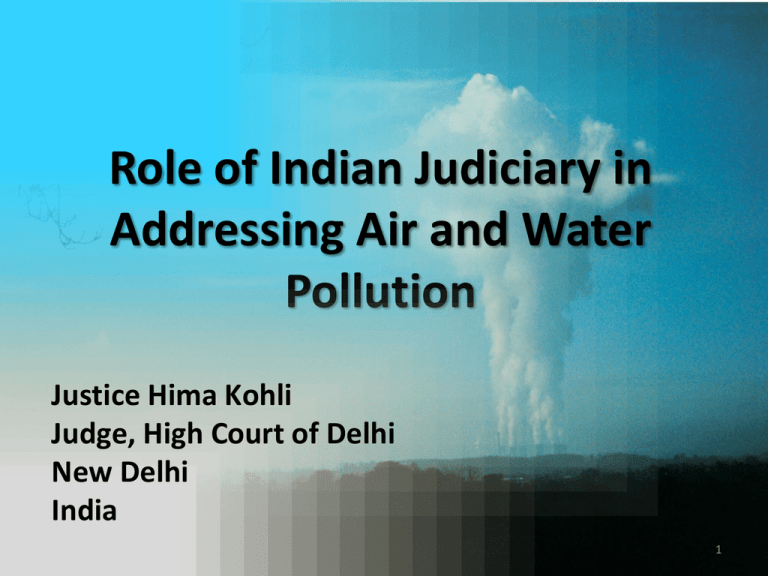
Role of Indian Judiciary in Addressing Air and Water Pollution Justice Hima Kohli Judge, High Court of Delhi New Delhi India 1 “The waters in the sky, the waters of rivers, and water in the well whose source is the ocean, may all these sacred waters protect me.” -Rig Veda, Book VII (Hymn 49, Verse 2) 2 • The Vedas, Upanishads, Puranas and other such ancient scriptures emphasize the importance of maintaining an ecological balance. • Objects of nature like air, water, trees, etc. have been worshiped in India and other ancient civilisations. 3 •It is the dharma/duty of each individual to protect the Nature. • The ancient Indian texts, Manusmritis, a compilation of ancient laws, prescribe different punishments for causing injury to plants. • Landmark summits and conferences have helped in shaping the modern environmental legislations of the world. • The Stockholm Conference, 1972, gave a major boost to the promulgation of environment legislation in India. 5 Legislations Legal Framework • Water (Prevention and Control of Pollution) Act, 1974 • Air (Prevention and Control of Pollution) Act, 1981 • Environment (Protection) Act, 1986 (EPA) • Hazardous Wastes (Management and Handling) Rules 1989 • The National Green Tribunal Act, 2010 6 Role of Indian Judiciary • The Supreme Court and the High Courts have developed environmental laws in India through careful judicial thinking. •The Courts have incorporated various international doctrines, combined with a liberal view towards ensuring social justice and the protection of human rights as a part of environmental jurisprudence under Article 21 of the Constitution of India. 7 Role of Public Interest Litigation • Majority of cases before the court are writ petitions, by individuals acting on a pro bono basis. • PIL is a result of the relaxation of the locus standi rules while departing from the “proof of injury” approach. • These cases are concerned with the rights of the community as a whole rather than an individual . 8 Ratlam Municipal Council vs Vardhichand [AIR 1980 SC 1622] • The Supreme Court had introduced the concept of PIL for the first time and had stated that a responsible Municipal Council constituted for the precise purpose of preserving public health, cannot run away from its principal duty by pleading financial inability. 9 M.C. Mehta vs UOI (Shriram Gas Leak Case) [AIR 1987 SC 1086] • Absolute Liability imposed on industries dealing with hazardous material. • Scope of Article 21 broadened by recognizing the right to claim compensation to victims of pollution hazards. 10 River Ganga, that rises from the western Himalayas, travels through the Gangetic plains to empty into the Bay of Bengal, has the most heavily populated river basin in the world. M.C. Mehta vs UOI (Ganga Pollution case) [AIR 1988 SC 1037] • Between 1988 to 1996, the Supreme Court had ordered and monitored shutting down of all the tanneries located along river Ganga that had failed to set up a primary treatment plant as the waste generated by them was found to be ten times more noxious than the domestic sewage waste. 12 Vellore Citizen Welfare Forum vs UOI [AIR 1988 SC 1037] • The untreated effluents of tanneries and industries was being directly discharged into the main source of water supply to the city of Vellore. • Principle of “absolute liability” upheld to also cover the cost of restoring environmental degradation. 13 M.C. Mehta vs UOI (Taj Trapezium Case) [AIR 1997 SC 734] • Supreme Court stepped in to control the damage caused to the ‘Taj Mahal’ and other monuments due to the emissions of air pollutants by the nearby industries. 14 M.C. Mehta vs UOI (Taj Trapezium Case) [AIR 1997 SC 734] •A block of monuments in the shape of a trapezium around the Taj was identified and the industries were ordered to change the fuel being used by them else, shift operations outside the trapezium. 15 MC Mehta vs UOI (Delhi CNG Case) • PIL on vehicular pollution in Delhi filed in 1985. The Supreme Court passed a series of orders as a part of the ‘continuous mandamus’ procedure. • In 1998, due to the dangerously high level of air toxin, the commercial buses were directed to change the fuel to CNG. • This transition was given effect to in a phased manner ending in the year 2002. 16 MC Mehta vs UOI (Delhi CNG Case) •The judgement had initially drawn severe criticism from various quarters. •Inconvenience was caused to the general public due to the limited supply of CNG. •In the long run this decision had been instrumental in a drastic drop of air toxins. •Today, all public transport in Delhi has switched to the use of CNG. 17 Research Foundation for Science Technology and Natural Resources Policy vs UOI (2007) 8 SCC 583 •The Supreme Court denied access to the French ship ‘Clemenceau’ to make port at the Alang Ship breaking yard. •Showing concern over the operation of the Shipbreaking resulting in maritime pollution, the Court asked for recommendations from a committee of technical experts constituted by it. 18 Research Foundation for Science Technology and Natural Resources Policy vs. UOI (2007) 8 SCC 583 • Directions were issued to the Government to enact a legislation on this aspect, and as an interim measure, the court had laid down a set of guidelines to be followed in order to mitigate the harm caused to the environment by this activity. 19 National Green Tribunal (NGT) •The NGT was established by the National Green Tribunal Act, 2010. • The NGT called upon state and the local authorities to perform their duties in curbing air and water pollution. •Recently 34 hotels in a famous Hill-Station in North India that were found dumping their waste material into the river Beas were ordered to be shut down by NGT. 20 National Green Tribunal (NGT) • As Delhi falls in seismic zone IV, the NGT has directed demolition of all unauthorized structures in Delhi erected on the riverbed and the flood plains of River Yamuna that are likely to cause ecological havoc as they have been built on a weak foundation of soft alluvial soil. 21 Conclusion • Environmental law has evolved at a fast pace establishing a number of fundamental principles for its better implementation. •Supreme Court of India and the High Courts of the States have incorporated various international doctrines relating to environment as part of the environmental jurisprudence in India. 22 Conclusion • The concept of PIL has facilitated access to justice for all classes of the society. • The doctrine of ‘public trust’ has deep roots in the constitutional commitments. 23 Conclusion • The Indian judiciary has proved itself to be a strategic partner in promoting environmental governance, in upholding the rule of law and in ensuring a fair balance between environmental, social and developmental considerations. 24 Thank You Justice Hima Kohli Judge, High Court of Delhi New Delhi India 25
